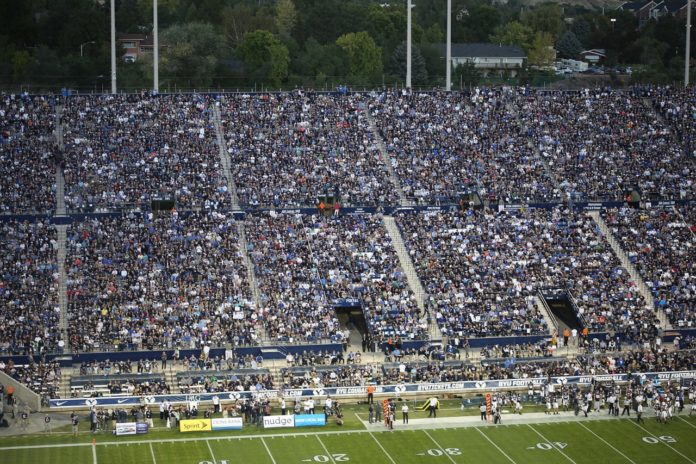College Offense – The Philadelphia Eagles and New England Patriots combined for a playoff-record 1,151 yards. The second-most points in a playoff game (74), and did so using staples of offenses in college football. The Patriots rarely used a huddle, opting instead to receive the play call from Tom Brady. They quickly get set and snap the ball to gain an advantage on the defense.
Save for the game-deciding strip-sack by the Eagles’ Brandon Graham, this strategy worked. Philadelphia’s vaunted defensive front became gassed and barely touched Brady in the second half.
Brady’s stat line mimicked a typical spread quarterback in college: 28 of 43 for 505 yards and three touchdowns. While the Patriots did end up losing the game. New England’s game-long commitment and implementation of spread passing concepts allowed the offense to pick apart one of the league’s best defenses.
College Offense
Chip Kelly was one of the first to commit to a total college offense in the NFL, but his four-year in run the league is largely viewed as a failure at this point. He made one playoff appearance as the head coach in Philadelphia and San Francisco. His offense got worse every year.
In 2013, his first season with the Eagles, his scheme looked unstoppable at times and finished second in the league in points per game and fourth in yards per game. By his third season, the offense was above average, putting up the 12th-most points and 14th-most yards. In his lone season with the 49ers, the offense ranked 31st in points and 27th in total yards.
Following Kelly’s ousting at the end of the 2016 season, you’d think the college offense experiment was over in the NFL.
Not so fast.
Andy Reid, the head coach of the Kansas City Chiefs, installed spread concepts to his offense over the last couple of years and it allowed quarterback Alex Smith to blossom. By opening up the playbook and getting the ball to playmakers like Travis Kelce, Kareem Hunt and Tyreek Hill, Smith had the best season of his career in 2017, throwing for over 4,000 yards for the first time with 26 touchdowns and just five interceptions.
That touchdown to interception ratio is eerily close to the NFL-record, which belongs to Nick Foles, who threw 27 touchdowns and two interceptions in 2013 in Chip Kelly’s scheme. Foles got injured the following year, then got traded to the Rams for Sam Bradford before the 2015 season. Foles spent much of the next two years as a backup, playing only on spot duty and regarded as a career backup by the time the Eagles signed him last offseason.
When star quarterback Carson Wentz blew out his knee in Week 14, Foles became the man in Philadelphia again. Everyone, including me, thought the days of Foles lighting up the league were long gone. The Eagles already ran a lot of spread concepts–namely, run-pass options–with Wentz, who led the NFL in touchdown passes before his injury. Even with his familiarity with the offense, the idea Foles could recapture his 2013 form and lead the Eagles through the playoffs seemed so far-fetched.
Doug Pederson Second Year Coach
This is where Doug Pederson came in. The second-year head coach watched film from Foles’ record-setting 2013 season and added even more spread wrinkles to his offense. The Eagles found Foles was most comfortable in run-pass options, and after working out the kinks in the final games of the regular season, the offense took off in the playoffs.
Foles completed over 70 percent of his passes in the playoffs. Many were simple screens and slants off of RPOs with a few deep shots sprinkled throughout the course of the game. The short passing game allowed Foles to get easy completions and become more confident. The stage never looked too big for him. He threw for 373 yards and three touchdowns in the Super Bowl, carving up a Bill Belichick defense like we’ve rarely seen before.
For so long, NFL coaches have tried to fit college quarterbacks into complicated pro-style offenses in which they aren’t comfortable. While there is a case to be made that pro-style quarterbacks have a higher success rate long term. Some coaches around the league are tailoring offenses around what has made their quarterbacks successful in the past.
Chicago Bears
This is no more evident than with the Chicago Bears’ coaching hires this offseason. The Bears hired Matt Nagy, who was the offensive coordinator for the Chiefs the last two seasons, as head coach. Nagy was a huge part of the Chiefs’ offensive overhaul, making the offense look similar to the one Alex Smith ran in college over a decade ago at Utah.
Nagy then hired Mark Helfrich as his offensive coordinator, who spent four years as Chip Kelly’s offensive coordinator at Oregon before Kelly was hired by the Eagles. Nagy and Helfrich will run an offense with a ton of spread concepts, in an attempt to put last year’s No. 2 pick Mitch Trubisky in the best possible position to succeed, as he did at North Carolina in 2016.
Offenses at the college level are becoming even more simplistic than they were just five or ten years ago, which means the learning curve for rookie quarterbacks in pro-style offenses is growing much higher. Rather than trying to fit a square peg in a round hole, I think NFL coaches are going to opt to simplify their offenses, which will make the transition much easier.
With the Nick Foles’ renaissance, Alex Smith’s career year and the Patriots dismantling of one of the NFL’s top defenses as evidence college offenses can be successful, it feels like we’re headed toward a total shift in offensive schemes across the league.



